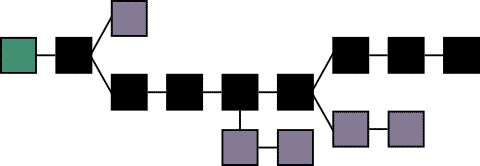A Blockchain Primer

The Blockchain is a fascinating technology that has the potential to disrupt a number of industries. This short primer will explain the basics.
What is the Blockchain? >
The Blockchain was created to enable the first viable digital currency, known as Bitcoin. The idea was to have a decentralized currency that did not rely on banks or other financial institutions for its integrity or legitimacy.
But, as we’ll see, the concept is fundamentally designed to be an integrity decentralization technology in general, and isn’t specific to financial use cases.
How it Works >
The Block Chain is a distributed database of transactions powered by public-key cryptography. The core concept that makes it different from centralized banks is that all transactions, and in fact all of the currency itself, is stored in a public ledger that is kept by all participants in the system.
Blocks are a key part of the technology, and they have the following characteristics:
they are small sets of transactions that have taken place within the system
each new block includes a SHA-256 hash of the previous transaction that which "chains" it to all previous blocks
blocks are computationally difficult to create, taking multiple specialized processors and significant amounts of time to generate
The fact that blocks are both difficult to generate, and that in order to change one you’d have to successfully change all previous ones, makes the block chain particularly resistant to tampering.
To send or receive money using Bitcoin (the most popular block chain implementation) one creates a Bitcoin address (really just a long alphanumeric token) that can be used to either send or receive. The use of the public/private keypairs ensures that payments are sent and received by the correct individuals.
Why it Matters >
The Blockchain concept is important because it represents a technological framework for decentralization. Many industries, such as banking, credit scoring, money transfers, etc., rely on someone in the middle to manage the integrity of the system, and they usually become extraordinarily rich in the process. Once they become one of—or the—standards, they can change rules, fees, etc. without much ability for consumers to object.
The Blockchain changes this by offering a system whereby the users themselves manage the entire process, and where there is full transparency into costs, fees, etc.
Summary >
The Blockchain is a technology framework for decentralizing a number of entities that used to require one or more middlemen and involve significant opacity
The system uses a public and transparent ledger of all activity that has taken place within it, and that ledger is simultaneously the currency as well as the record of how the currency has been created and moved among nodes
The integrity of the system is handled through the use of public-key cryptography and continuous, computationally intense validation by nodes in the system
There is significant opportunity for disruption using this technology, as many middleman entities, such as banks, are ripe for replacement using more transparent options that offer lower fees
Notes
This primer is designed to explain the core concept. If you want technical details I suggest reading Satoshi’s original paper, which can be found here >.
An interesting distinction between a block chain based system and a traditional central authority is that in traditional systems a record talks about what is true of objects outside the ledger, whereas with digital currency the ledger and the currency are actually the same.
While transparency is usually a good thing, there are certain types of industries and transactions that value privacy, which the Blockchain technology isn’t perfect for.